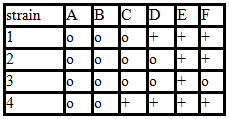Biodiversity is described in terms of genetic, community, and landscape diversity.
Answer the following statement true (T) or false (F)
True
It is true that biodiversity is described in terms of genetic, community, and landscape diversity.
You might also like to view...
If nitrifying bacteria were not present in a soil, plants would ____
a. take up nitrogen for their use mainly as NH4+ b. not survive because they could not get useful nitrogen c. take up nitrogen for their use mainly as N2 d. take up nitrogen for their use mainly as NH3 e. take up nitrogen for their use mainly as NO3-
Which biochemical pathway fits the data presented?
Assume that a series of compounds has been discovered in Neurospora. Compounds A–F appear to be intermediates in a biochemical pathway. Conversion of one intermediate to the next is controlled by enzymes that are encoded by genes. Several mutations in these genes have been identified and Neurospora strains 1–4 each contain a single mutation. Strains 1-4 are grown on minimal media supplemented with one of the compounds A-F. The ability of each strain to grow when supplemented with different compounds is shown in the table (+ = growth; o = no growth).
media supplement

A) A ? B ? C ? D ? E ? F
B) A ? B ? C ? F ? D ? E
C) F ? B ? C ? D ? A ? E
D) A ? B ? C ? D ? F ? E
E) A ? B ? F ? E ? C ? D
According to the Hardy-Weinberg principle, which of the following must be true for gene frequencies in a population to remain the same?
A) Mating is random. B) Mutations occur consistently. C) The population is small. D) Natural selection occurs.
Which is not a stimulus that exteroceptors can sense?
A. Muscle tension B. Sound C. Gravity D. Smell E. Light